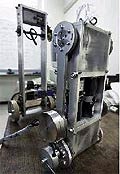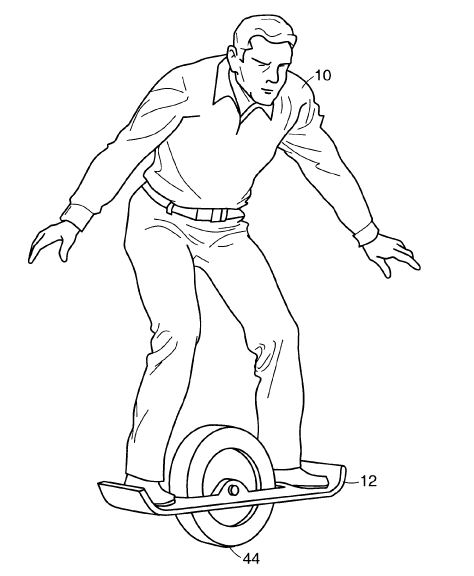EARLY HISTORY of one and two wheeled self-balancing machines.
We all know about the Segway, but even there the story is not straightforward.
Kazuo Yamafuji, Professor Emiritus at Tokyo’s University of Electro-Communications, claimed to have had the idea first. In his case it was in the form of a self-balancing robot or parallel-bicycle as he called it.
Yamafuji applied for a patent for his machine in 1987, which was granted in 1996.
This very small image is the only one I can find of it.

The Segway, developed by Dean Kamen had a patent applied for on June 4th 1999 and awarded in 2000. This is not a patent of ‘self-balancing’ as a broad concept but it covers all the practical and technical details required to make a Segway work.
It is also worth noting in the context of one-wheeled skateboards, that there is a diagram (see below) at the end which clearly describes a possible embodiment – as a one wheeled skateboard.
With respect to patents, it is not possible to patent something that has already been patented or that is already (as an idea) already in the public domain.
Therefore the idea of a one-wheeled self-balancing skateboard, was in the public domain in 2000.

2001.
The Elektrisches-Einrad-Fahrzeug.
This is the first working one-wheeled self-balancer I can find, in the form of a wide-tired unicycle. They should perhaps have reconfigured it as a skateboard. There is very little on the modern internet about this machine and it seems almost forgotten, not by me though.
It was developed by Professor Dr.-Ing. habil. Klaus Hofer from the Department of Electrical Engineering and Information Technology, the University of Applied Sciences (FH) Bielefeld, Germany.
Video extract from a TV News report made at the time below.
Link to the only article I can find about this:
July 16, 2006
Ginger 2, a home made segway twin-wheeler project.
Feb 16th 2007
Stanford University skateboard with 2 wheels.
Self-Balancing Skateboards in general: When it comes to self-balancing skateboards we may think these appeared around 2015. This is not so. In fact things really got going around 2007.
4th March 2007
Ben Smithers skateboard
This is the video everyone took notice of, including myself and I became determined to build one.
It is reasonably fast, stable and steerable…….back in 2007.
April 24, 2007
Segway project from Asia
Sep 17, 2007
Another good, working, self balancing skateboard.
Trevor Blackwell website describing how to build your own Segway. I am not sure of the date but this was one of the earliest DIY projects described. I studied his code closely when trying to build mine.
http://www.tlb.org/scooter.html
2007
MIT segway project.
The downloadable technical specifications were very useful for my very early projects and definitely read the article on the “balance filter” by Shane Colton. This explains in plain English how simple (relative to a Kalman filter anyway) self balancing can be made to work and how the signals from the gyro and the accelerometer are used. Without this article I would have really struggled to understand how this can be done although elements of this algorithm appear in the software of others in this list.
Autumn 2007
A university self-balancing one-wheeled skateboard project, not quite perfected but getting there.
9/1/2008
Maiden voyage of the “Leviskate” self balancing skateboard by Rodger Cleye.
Here he is again riding his next version in 2012, while also playing guitar!
May 7, 2008
Another early skateboard project.
This is my own second version from 2009. The Hot-Wheel. 500 Watt motor. Chain driven using go-kart parts. Two lead-acid motorcycle batteries. It was very heavy but it worked OK.
This isn’t a self-balancer but it does have one wheel, and a huge counterweight inside the wheel: The RIOT wheel.
MONOWHEELS
Monowheel from the 1930’s.
NOTE: many modern versions of this design exist and are steered by shifting weight.
However, watch this 1930’s machine very carefully and you can see that the wheel can be tilted to the left or right while the rider remains more or less upright. The contact point on the ground remains under the rider but the contact patch now becomes C-shaped and so this means it can be steered using the steering wheel.
I am not aware of any modern versions that use this steering system. It’s about time someone had a go….
It has much more going on in terms of the steering mechanism than you might at first think. This is all hidden under the seat. Consider also that the drive to the wheel rim must also be maintained even while the wheel is tilting.
Modern MonoVelo pedal monowheel as used in the Chinese Olympics opening ceremony.
The vehicles of Charles Taylor. These used large spinning metal gyros for both balancing and reaction-steering. This represents a different approach to the self-balancing problem.
An experimental train and at least one two wheeled car were built using spinning gyros to keep them upright.
Here is an example of a car which has recently been restored.